Mars Desert Research Station, Hanksville, Utah, USA - June 01, 2014 - The Challenge: Design and build the next generation of Mars rovers that will one day work alongside human explorers in the field. 1st Place: Hyperion Team - Bialystok University of Technology (Poland) - 368 Points. 2nd Place: Mars Rover Design Team - Missouri University of Science & Technology (USA) - 342 Points. 3rd Place: Legendary Rover Team - Rzeszow University of Technology (Poland) - 338 Points. Judges' Award for Most Innovative Design: BYU Mars Rover Team - Brigham Young University (USA). Congratulations to all of the teams!
 |
The returning champions from the Hyperion Team (Technical University of Bialystok, Poland), prepares for their first task of 2014, the Sample Return Task.
Courtesy of 2014 University Rover Challenge |
| |
Mars Desert Research Station, Hanksville, Utah, USA - June 01, 2014
The University Rover Challenge (URC) is an annual international competition hosted by the Mars Society for University and College students to complete a given scenario using a rover the team has built.
The competition is held at the Mars Desert Research Station, outside Hanksville, Utah.
The site was selected by the Mars Society for its geographic similarity to Mars - in addition to being a largely barren desert area, the soil in the area has a chemical composition nearly identical to Martian soil.
The competition is run under the basic assumption that the rovers being designed are being designed as assistive rovers for a manned mission to mars, and as such, are allowed recharge times between events, and are allowed un-delayed radio communications with the team running the rover.
The most recent year's event also required that the propulsion and power systems of the rover be easily adaptable to Martian conditions, greatly limiting the practicality of using internal combustion engines at the competition.
 |
| Courtesy of 2014 University Rover Challenge |
| |
The winning team will receive transportation, lodging and admission for five individuals to present their rover at the Annual International Mars Society Convention, as well as cash prizes.
The Mars Society is a space advocacy non-profit organization dedicated to promoting the human exploration and settlement of the planet Mars. Established by Dr. Robert Zubrin and others in 1998, the organization works to educate the public, the media and government on the benefits of Mars exploration and the importance of planning for a humans-to-Mars mission in the coming decade.
The Society was formally established in August 1998, when over 700 delegates – astronomers, scientists, engineers, astronauts, entrepreneurs, educators, students, and space enthusiasts – attended a weekend of talks and presentations from leading Mars exploration advocates.
 |
A panoramic view of the Musk Observatory with the Terrain Traversing Task in the background.
Courtesy of 2014 University Rover Challenge |
| |
Since then, the Society, guided by its International Steering Committee, has grown to over 4,000 members and some 6,000 associate supporters across more than 50 countries around the world.
Members of the Society are from all walks of life, and all actively work to promote the ideals of space exploration and the opportunities for exploring Mars.
Mars Society Polska (MSP)
Mars Society Polska (MSP) is actively participating in the creation of the Polish space industry.
Since this sector is still developing, the organization is taking the opportunity to provide a strong Mars-related element for the years to come.
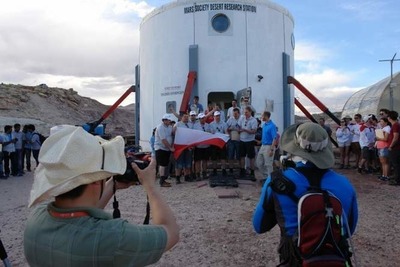 |
Champions from the Hyperion Team (Technical University of Bialystok, Poland).
Courtesy of the Hyperion Team |
| |
Poland was the last member state of the EU to sign the cooperation agreement with ESA.
Most projects in Poland currently focus on satellite technology, so MSP is the only leading organization promoting exploration and manned spaceflight.
Besides private sponsors, it relies on resources obtained from the Ministry of Science and Higher Education and local authorities, proposing projects to be undertaken with local communities and thus engaging with the general public.
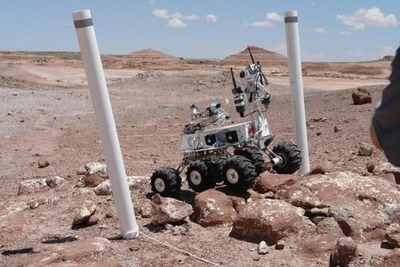 |
The Hyperion 2
Courtesy of the Hyperion Team |
| |
MSP's first project was the Polish MPV (pressurized rover) design, for which some hardware was produced.
This enabled development of the Polish Mars Society itself, together with a number of educational activities for Polish schools.
This was followed by the joint organization of the Polish edition of the Red Rover Goes to Mars contest and organization of a Mars colonization negotiation game (Columbia Memorial Negotiations).
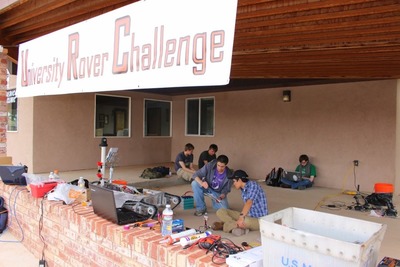 |
Dubotics (University of Washington) works on their tank-style rover in Hanksville during a quiet moment in the schedule.
Courtesy of 2014 University Rover Challenge |
| |
In 2007 MSP organized the first Mars Festival, a two-day event which drew 600 visitors, with Discovery Channel as the main sponsor.
Mars Festival 2008 was smaller due to the efforts being made in other projects, particularly the Polish URC rover, named Skarabeusz.
The flagship MSP project is the Polish Martian habitat, based on a design by Janek Kozicki.
It has three inflatable modules attached and a usable surface of 900 m2.
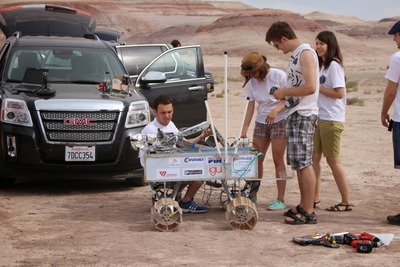 |
The ERIS Project
Courtesy of 2014 University Rover Challenge |
| |
The habitat is to be located close to a large town, meaning that beyond its role as a test site, largely for materials and design, it will be accessible to the wider public and media.
MSP has established a constant presence in the mainstream Polish media and is working on a documentary about itself.
It is also developing software projects, IT systems for the future martian habitat, with a Virtual Mars Base and remote access.
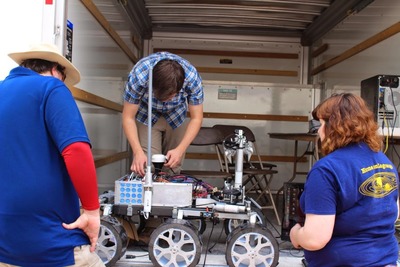 |
MRover (University of Michigan, Ann Arbor) prepares for the Astronaut Assistance Task.
Courtesy of 2014 University Rover Challenge |
| |
Jan Kotlarz of MSP has created RODM software for the modeling of the Martian surface based on high resolution photographs from Mars Reconnaissance Orbiter.
RODM is currently being tested by NASA and ESA.
2014 University Rover Challenge
The Challenge:
Design and build the next generation of Mars rovers that will one day work alongside human explorers in the field.
The Prize:
Cash prizes, a trip to present at the annual International Mars Society Convention, and a year’s worth of bragging rights.
2014 University Rover Challenge:
May 29-31, 2014
Mars Desert Research Station
Hanksville, Utah, USA.
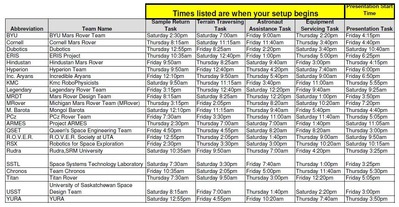 |
| Courtesy of 2014 University Rover Challenge |
| |
URC 2014 Schedule
Wednesday, May 28, 2014
Early check-in (optional) at the Hanksville Town Hall
Driving tour of route to MDRS (departs from Town Hall)
Driving tour of route to MDRS (departs from Town Hall)
Thursday, May 29, 2014
Check-in at the Hanksville Town Hall
Driving tour of route to MDRS (departs from Town Hall)
First competition tasks begin
URC Competition Tasks
Friday, May 30, 2014
URC Competition Tasks - All Day
Saturday, May 31, 2014
URC Competition Tasks - All Day
5:00pm - 8:00pm URC Bar-B-Que and Awards Ceremony (this is a casual event)
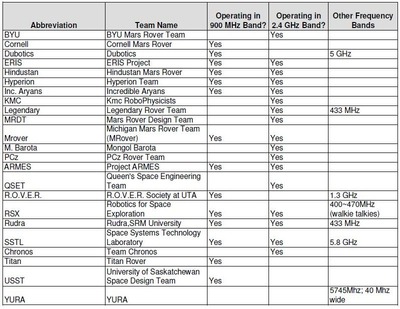 |
| Courtesy of 2014 University Rover Challenge |
| |
2014 University Rover Challenge Scores
1st Place: Hyperion Team - Bialystok University of Technology (Poland) - 368 Points.
2nd Place: Mars Rover Design Team - Missouri University of Science & Technology (USA) - 342 Points.
3rd Place: Legendary Rover Team - Rzeszow University of Technology (Poland) - 338 Points.
Judges' Award for Most Innovative Design: BYU Mars Rover Team - Brigham Young University (USA).
Congratulations to all of the teams!
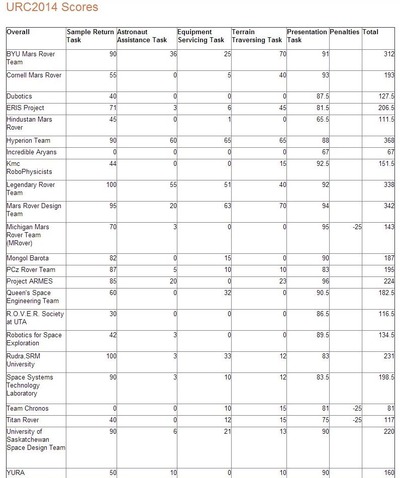 |
| Courtesy of 2014 University Rover Challenge |
| |
2013 University Rover Challenge
Top Three
1. Hyperion Team (Bialystok University of Technology), Poland
2. Scorpio 3 (Wrocław University of Technology), Poland
3. Brigham Young University, USA
Year of Records at 2013 University Rover Challenge
The 2013 University Rover Challenge (URC) concluded Saturday evening by crowning the third two-time champion in its seven year history.
The Hyperion Team from Bialystok University of Technology (Poland) impressed the judges early on during the Sample Return Task, and only improved from there.
They finished with a URC record 493 points (out of 500 possible), outscoring the nearest competitor by 91 points.
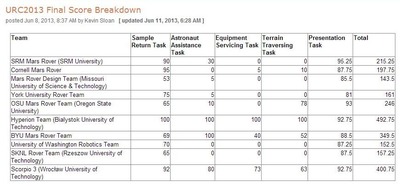 |
| Courtesy of 2014 University Rover Challenge |
| |
URC is a Mars Society-organized international robotics competition for college students who design and build Mars rovers.
The annual event is held at the Mars Desert Research Station (MDRS) near Hanksville, Utah, home to leading Mars exploration research.
Source: 2014 University Rover Challenge
http://urc.marssociety.org
Marsjański łazik studentów z Białegostoku Hyperion 2 ponownie najlepszy na świecie
Łazik marsjański studentów Politechniki Białostockiej Hyperion 2 zwyciężył w zawodach University Rover Challenge 2014 w USA.
Zawody zostały rozegrane w dniach od 29 do 31 maja 2014 roku na Marsjańskiej Pustynnej Stacji Badawczej (ang. Mars Desert Research Station) w Hanksville w stanie Utah w USA.
Polska drużyna z Białegostoku wygrała drugi rok z rzędu.
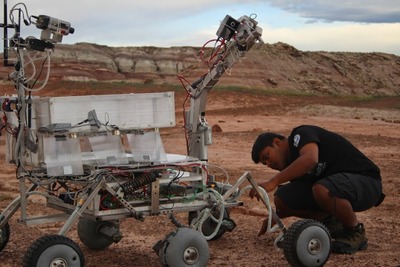 |
Team Rudra (SRM University, India) preparing their rover for the Astronaut Assistance Task.
Courtesy of 2014 University Rover Challenge |
| |
W tym roku ponownie są dwie polskie drużyny w pierwszej trójce najlepszych zespołów akademickich z całego świata.
W ubiegłym roku drugie miejsce na świecie za zespołem Hyperion z Białegostoku zajął zespół Scorpio 3 studentów Politechniki Wrocławskiej.
W tym roku trzecie miejsce zajęli studenci z Politechniki Rzeszowskiej.
Drużyna Wydziału Mechanicznego Politechniki Białostockiej na zakończonych w niedzielę czasu polskiego mistrzostwach na pustyni w stanie Utah wygrała po raz drugi z rzędu - jako pierwsza w historii tych zawodów.
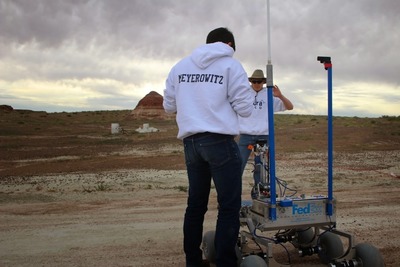 |
The Yale University Rover Association (YURA) performs a literal "handshake" test with their rover's manipulator prior to the Equipment Servicing Task.
Courtesy of 2014 University Rover Challenge |
| |
Zwycięstwo odniosła drużyna Hyperion Team w składzie: Michał Grześ, Jacek Wojdyła, Jakub Maliszewski, Robert Bałdyga, Maciej Baka, Maciej Rećko.
Studenci zaprezentowali łazika Hyperion 2, następcę Hyperiona, który wygrał ubiegłoroczne University Rover Challenge.
Na podium zawodów stanęła również drużyna studentów z Politechniki Rzeszowskiej - Legendary Rover Team - zajęła trzecie miejsce.
Drugie miejsce zdobyła ekipa z Missouri University of Science and Technology (USA) z robotem Mars Rover Design Team.
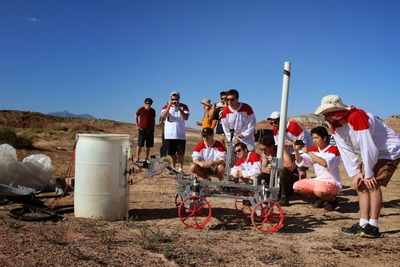 |
The Queen's Space Engineering Team (Queen's University Canada) team looks on in eager anticipation as their rover begins work at the Equipment Servicing Task.
Courtesy of 2014 University Rover Challenge |
| |
W zawodach łazików marsjańskich przygotowanych przez studentów wzięły udział 23 drużyny z całego świata.
Hyperion Team zajęła pierwsze miejsce, zdobywając 368 punktów.
Kolejne drużyny otrzymały 342 i 338 punktów.
W ubiegłym roku studenci z Białegostoku zdobyli rekordową liczbę punktów - 493 na 500 możliwych.
„W tym roku zadania były 2-3 razy trudniejsze niż w poprzednich latach. Prawie żadnej konkurencji nie dało się uczestnikom wykonać na 100 procent" – tłumaczył opiekun naukowy projektu dr hab. inż. Kazimierz Dzierżek, Prodziekan ds. Promocji i Współpracy Wydziału Mechanicznego Politechniki Białostockiej.
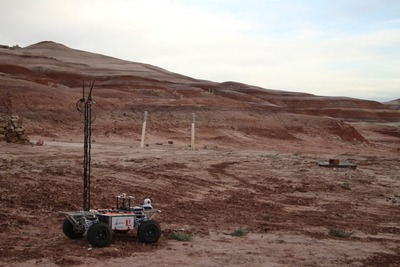 |
Project ARMES (York University, Canada) looks out at three of the gates in the Terrain Traversing Task.
Courtesy of 2014 University Rover Challenge |
| |
Dobrze studentom Wydziału Mechanicznego Politechniki Białostockiej poszło zadanie polegające na pobraniu próbki w terenie i znalezieniu w niej życia - 90 punktów.
Za prezentację projektu i łazika studenci otrzymali 88 punktów.
„Obsługa panelu operatorskiego poszła nam nieźle. Wykonywaliśmy poszczególne części zadania szybciej niż inne drużyny. Nie udało się w wyznaczonym czasie zrobić wszystkiego, ale jest naprawdę nieźle" – komentowali uczestnicy drużyny w trakcie zawodów.
Tuż po zakończeniu konkurencji Terrain Traversing Task (jazda po trudnym marsjańskim terenie) drużyna Politechniki Białostockiej na swoim profilu na Facebooku napisała:
„ Już po traversingu. Póki co jesteśmy jedyną drużyną, której udało się pokonać podjazd z kamieniami. Najwyżej położona bramka też nie stanowiła dla nas wielkiego problemu. Niemal udało nam się przejechać niezdobytą do tej pory bramkę umieszczoną bokiem na 45-stopniowym zboczu".
W tej konkurencji drużynę z Białegostoku pokonała jedynie ekipa z Missouri, wyprzedzając polski zespół o 5 punktów.
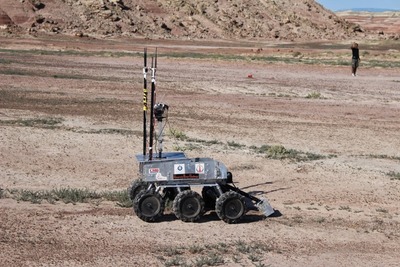 |
Space Systems Technology Laboratory (University of Cairo, Egypt) uses their bucket scoop in an attempt to pick up tools at the Astronaut Assistance Task.
Courtesy of 2014 University Rover Challenge |
| |
Dramatyczne informacje przekazywała drużyna po zadaniu Astronaut Assistance Task (pomoc astronaucie).
Wtedy drużyna napotkała problemy techniczne.
W trakcie dostarczania pakietów ratunkowych astronautom uszkodzona została część manipulatora łazika.
Nie pozwoliło to na wykonanie w wyznaczonym czasie całego zadania.
"Mimo popsutego manipulatora udało się jednak dostarczyć narzędzia do dwóch z czterech astronautów. Warto dodać, że problem z tym zadaniem miało wiele drużyn, które na koniec otrzymywały po kilka punktów. Za to zadanie Hyperion Team otrzymała 60 punktów wyprzedzając kolejną w punktacji drużynę z Rzeszowa o 5 oczek."
„ 368 punktów przy tak trudnych konkurencjach to dobry wynik” – powiedział po wręczaniu nagród dr hab. inż. Kazimierz Dzierżek.
„ Warto dodać, że byliśmy pod presją ubiegłorocznego wyniku."
„W ubiegłym roku zdobyliśmy szczyt. Trudno wejść wyżej" – stwierdziła dr inż. Justyna Tołstoj-Sienkiewicz, opiekunka koła naukowego robotyków, w ramach którego zaprojektowano i zbudowano łazika marsjańskiego HYPERION 2.
Budowa robota oraz finansowanie wyjazdu na zawody odbywało się w ramach projektu Ministerstwa Nauki i Szkolnictwa Wyższego "Generacja Przyszłości".
Uczelnia pozyskała także dobrego sponsora – Bank PKO BP SA.
Warto przypomnieć, że drużyna Politechniki Białostockiej już trzy razy wygrała te zawody:
- w 2011 roku z łazikiem Magma 2,
- w 2013 roku z łazikiem Hyperion oraz
- w 2014 roku z łazikiem Hyperion 2.
Źródło: 2014 University Rover Challenge
http://urc.marssociety.org
ASTROMAN Magazine - 2014.01.02
DARPA Robotics Challenge Trials Conclude: Number 1 is SCHAFT
http://www.astroman.com.pl/index.php?mod=magazine&a=read&id=1628
ASTROMAN Magazine - 2013.12.15
Boston Dynamics: Changing Your Idea of What Robots Can Do
http://www.astroman.com.pl/index.php?mod=magazine&a=read&id=1606
ASTROMAN Magazine - 2013.12.03
Polish team won Programming Marathon24
http://www.astroman.com.pl/index.php?mod=magazine&a=read&id=1596
ASTROMAN Magazine - 2013.11.24
The Martin Jetpack - Fly the dream
http://www.astroman.com.pl/index.php?mod=magazine&a=read&id=1590
ASTROMAN Magazine - 2013.09.14
Polish start-up Estimote Wins PCH Incubator Highway1's Award for Best Hardware Startup in California
http://www.astroman.com.pl/index.php?mod=magazine&a=read&id=1556
ASTROMAN Magazine - 2013.07.13
Polski hotel podwodny Water Discus podniesie prestiż Resortu ZEN na Malediwach w branży turystycznej
http://www.astroman.com.pl/index.php?mod=magazine&a=read&id=1496
ASTROMAN Magazine - 2013.04.21
Wielki światowy sukces polskich studentów na Aero Design 2013, California, USA
http://www.astroman.com.pl/index.php?mod=magazine&a=read&id=1446
ASTROMAN Magazine - 2013.04.21
Wroclaw University of Economics Crowned Winner of Seventh Annual CFA Institute Research Challenge Student
http://www.astroman.com.pl/index.php?mod=magazine&a=read&id=1447
ASTROMAN Magazine - 2013.02.01
Amazon.com Announces Acquisition of IVONA Software
http://www.astroman.com.pl/index.php?mod=magazine&a=read&id=1405
ASTROMAN Magazine - 2013.01.20
Polska nowatorska koncepcja podwodnych hoteli Water Discus
http://www.astroman.com.pl/index.php?mod=magazine&a=read&id=1393
ASTROMAN Magazine - 2012.07.22
Spintronika: Powstał nowy typ tranzystora, owoc polskiej technologii
http://www.astroman.com.pl/index.php?mod=magazine&a=read&id=1281
ASTROMAN Magazine - 2012.07.16
Filatelistyczny Oscar dla polskiego znaczka pocztowego pachnącego jałowcem
http://www.astroman.com.pl/index.php?mod=magazine&a=read&id=1274
ASTROMAN Magazine - 2012.06.05
Wicemistrzowie świata i Mistrz Polski w programowaniu z firmy CodiLime zainwestują w Białymstoku
http://www.astroman.com.pl/index.php?mod=magazine&a=read&id=1251
ASTROMAN Magazine - 2012.01.28
Pierwszy polski satelita studencki PW-Sat poleci w kosmos 9 lutego 2012
http://www.astroman.com.pl/index.php?mod=magazine&a=read&id=1160
ASTROMAN Magazine - 2011.07.16
Microsoft Reveals Imagine Cup 2011 Winners in New York City
http://www.astroman.com.pl/index.php?mod=magazine&a=read&id=1018
ASTROMAN Magazine - 2011.06.05
Polski łazik marsjański MAGMA2 najlepszy na świecie
http://www.astroman.com.pl/index.php?mod=magazine&a=read&id=989
ASTROMAN Magazine - 2010.02.08
Polscy naukowcy modernizują akceleratory w CERN
http://www.astroman.com.pl/index.php?mod=magazine&a=read&id=660
ASTROMAN Magazine - 2010.01.10
Polskie satelity zbadają w kosmosie najgorętsze gwiazdy
http://www.astroman.com.pl/index.php?mod=magazine&a=read&id=637
ASTROMAN Magazine - 2009.11.14
Polscy emigranci zarobili 125 miliardów EUR
http://www.astroman.com.pl/index.php?mod=magazine&a=read&id=599
ASTROMAN Magazine - 2009.08.19
Zwycięstwo studentów Politechniki Warszawskiej w konkursie General Electric "Make Your Campus Greener"
http://www.astroman.com.pl/index.php?mod=magazine&a=read&id=560
ASTROMAN Magazine - 2009.07.11
Instytut Problemów Jądrowych dołączył do japońskiego programu badań kosmicznych
http://www.astroman.com.pl/index.php?mod=magazine&a=read&id=538
ASTROMAN Magazine - 2009.07.11
Imagine Cup 2009 - trzy polskie drużyny na podium
http://www.astroman.com.pl/index.php?mod=magazine&a=read&id=537
ASTROMAN Magazine - 2008.03.12
Polacy zwycięzcami Imagine Cup 2007 Akcelerator Innowacji
http://www.astroman.com.pl/index.php?mod=magazine&a=read&id=337
Editor-in-Chief of ASTROMAN magazine: Roman Wojtala, PhD.
|

